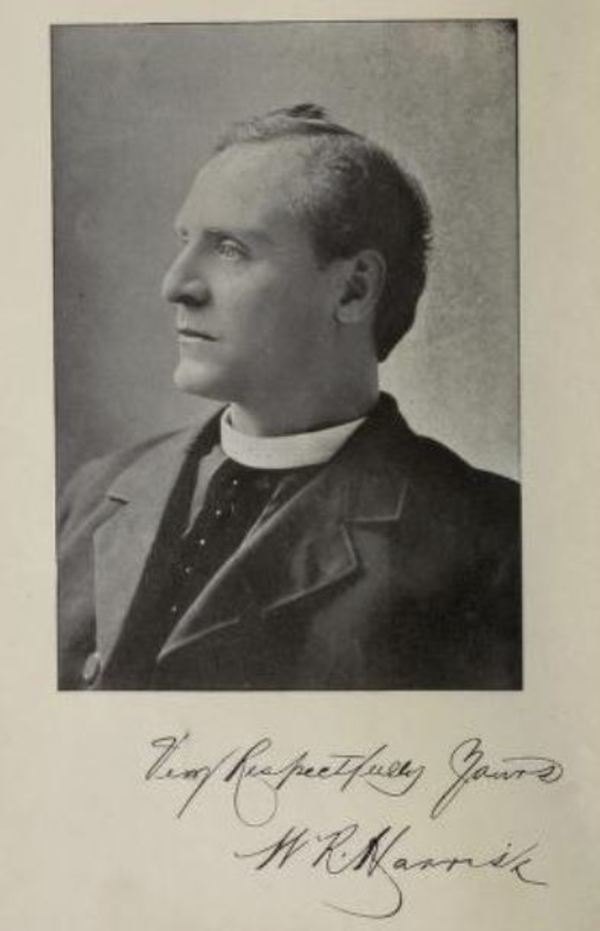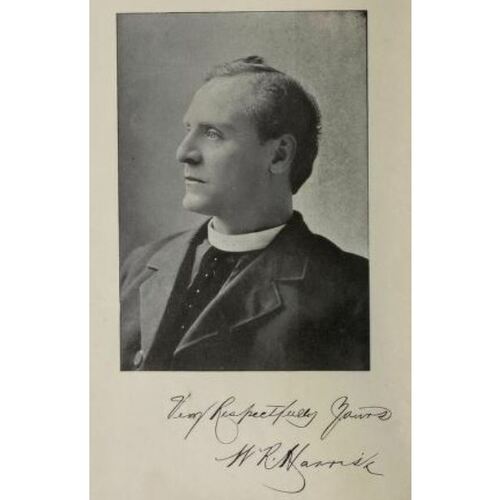
Source: Link
HARRIS, WILLIAM RICHARD, Roman Catholic priest and author; baptized 28 Feb. 1846 in Cork (Republic of Ireland), son of Richard Harris and Ellen Cotter; d. 5 March 1923 in Toronto.
William Richard Harris was always reticent about his family, even suppressing any mention that his sister Mary was Mother Jones, the famous American labour leader. The family may have settled in Toronto as early as 1853. Harris was first educated by the Brothers of the Christian Schools, and from 1860 to 1867 he took his classical studies at St Michael’s College. Favoured by his bishop, John Joseph Lynch*, a fellow Irishman, he was sent to study philosophy and theology at the Collège de Sainte-Anne-de-la-Pocatière in Quebec. He taught English and belles-lettres at the college and earned a reputation as a formidable athlete.
In 1869 Lynch appointed Harris his secretary and took him to Rome for the opening of the first Vatican Council. There he completed his bd degree at the college of the Sacred Congregation of Propaganda and was ordained priest on 11 June 1870. The two men toured the continent before returning to Toronto. Harris would never forget his European experiences, which whetted his appetite for travel and adventure.
Harris subsequently served as assistant pastor and then pastor of St James in Colgan, Ont. (1870–75), rector of St Michael’s Cathedral in Toronto (1875–76), and pastor of St John Chrysostom in Newmarket (1876–84). Energetic, ambitious, and committed to “square dealing” with his flock in financial matters, he was a building priest in an era when the erection of churches and schools was the summit of Catholic clerical success. At the same time he was thoroughly modern for his day. Believing that the prejudices transferred from the Old World had to die if Canada was to flourish as a nation, he made himself a leading example of ecumenical behaviour. In Newmarket he was an important patron of the local library and mechanics’ institute, for in his view adults no less than their children should acquire an education to meet the demands of an emerging industrial world.
Harris’s final parish appointment was as priest of St Catherine of Alexandria in St Catharines from 1884 to 1901, when he was also dean of St Catharines. His policies of openness in financial matters, church-related construction, and religious toleration were continued with even greater results. He printed two audited statements of the parish finances, erected a separate school with his own money, decorated and enlarged the church, collected funds to build the Canadian Lyceum and Athletic Club, which was open to all city athletes, and warned his parishioners, many of whom were Irish-born, not to be gulled into sectarian violence no matter the provocation. Responding quietly to one Presbyterian minister’s attack on Catholicism, he wisely left it up to Presbyterians and the public at large to judge “the wisdom or expediency of a minister of the gospel of Christ scattering in the furrows of society the seeds of religious rancour and bitterness.”
Before too long, Harris had acquired a public persona rare among the Catholic clergy of his day. He had transcended factionalism of all kinds, without sacrificing his own religious faith and Irish nationalism, in favour of a kind of public service that dovetailed with his own broader interests in continuing education and Irish Home Rule. In addition to being in great demand as a preacher, Harris was elected president of the Association of Mechanics’ Institutes of Ontario for 1886, the first Catholic to serve in this capacity; delivered a paper to the Pan-American Congress of Religion and Education in Toronto in 1895; was invited to lecture before the St Catharines Historical Society; and in 1896 was one of the Canadian delegates at the Irish Race Convention in Dublin.
The St Catharines period witnessed the beginning of Harris’s prolific writing career. That career, so central to his public reputation, would not have been possible without David Boyle*, head of the Canadian Institute Museum and Ontario’s first professional archaeologist, whose excavation of a Neutral Indian site near Port Colborne in 1887 inspired Harris to begin writing about the natives and early French missionaries. His first scholarly article, “The Indian missions in western Canada” – western Canada, for Harris, meant Ontario – was published in 1892 and then expanded the next year into a book, History of the early missions in western Canada (Toronto). Eight articles followed by 1901, including “The Roman Catholic Church in Ontario,” his contribution to John Castell Hopkins’s Canada, an encyclopædia of the country, as did his classic work of history and archaeology, The Catholic Church in the Niagara peninsula, 1626–1895, published in Toronto by William Briggs in 1895. This book earned him a place in the small but influential world of English Catholic letters and is the one book still in general circulation today. In recognition of his achievement, the University of Ottawa awarded him an honorary degree in 1896.
Just when Harris should have been enjoying the fruits of his success, a division took place in the parish over his handling of the finances. He had lost the trust of enough parishioners to ask Archbishop Denis O’Connor* for his unrestricted release from parish work, an exeat granted without question in April 1901. Harris soon set off on travels that were to last more than four years and take him to the Azores, the Caribbean, South and Central America, Mexico, and the southern United States. No idle tourist, he regularly contributed lengthy descriptions of his adventures to the Toronto Daily Star. These articles and other material were later compiled into three travel books of extraordinary quality: Days and nights in the tropics (Toronto, 1905), By path and trail (Chicago, 1908), and Here and there in Mexico (Chatham, Ont., [1920?]). They remain very readable, for Harris was a natural storyteller, obviously at ease with the world of the exotic and the bizarre.
By June 1905 Harris was living in Salt Lake City, where Bishop Lawrence Scanlan gave him the task of writing an official history of his diocese, published there in 1909 as The Catholic Church in Utah. Other undertakings included articles for The Catholic encyclopedia, regular contributions to the diocesan newspaper, and the publication of By path and trail and Pioneers of the cross in Canada (Toronto, 1912). When he was not writing, Harris was chaplain at Kearns St Ann’s Orphanage and then at Judge Mercy Hospital.
In January 1913 Harris, who had returned to Canada, became chaplain of St John’s Industrial School for Boys in Toronto. He also entered upon the most productive period in his life: he would write five books, 25 articles, and even some poetry. His reputation for religious tolerance in Protestant Toronto was almost legendary. He received two more honorary degrees, from the University of Toronto in 1916 and the Université Laval in 1920, and he was elected twice by acclamation as president of the Ontario Archaeological Association, in 1919 and 1920.
Harris’s death on 5 March 1923 was given extensive coverage in all the Toronto newspapers. During his life his many books had received much positive publicity. Time, however, has not been kind to his oeuvre. Although his writing is strong in narrative and style, his lack of training in research, his uncritical acceptance of sources, and his fondness for superlatives combine to rank him as a gifted amateur. However, the sheer volume of his output and the beauty of much of his writing laid the foundation for later generations of scholars to write the history of Catholic Ontario.
Harris’s first publication, “The Indian missions in western Canada,” originally appeared in Jubilee volume, 1842–1892: the archdiocese of Toronto and Archbishop Walsh, [ed. J. R. Teefy] (Toronto, 1892), 1–36. Bibliographies of his writings appear in R. J. Scollard, “Reverend William Richard Harris, 1846–1923,” CCHA, Study sessions, no.41 (1974): 65–80, and Michael Power, “An introduction to the life and work of Dean Harris, 1847–1923,” in Catholics at the “Gathering Place”: historical essays on the archdiocese of Toronto, 1841–1991, ed. M. G. McGowan and B. P. Clarke (Toronto, 1993), 119–36. Two manuscripts by Harris, “Travel notes and autograph album” (1894–1902) and “Notes of foreign travel” (1900–7), are preserved in the Univ. of St Michael’s College Library, Toronto.
Arch. of the Roman Catholic Archdiocese of Toronto, Clergy biog. and ministry database; SC, AB02.05(a–b), AB02.06. QUA, Lorne and Edith Pierce coll., Thomas O’Hagan, “Dean Harris” (1924). St Mary’s [North Cathedral] (Cork, Republic of Ireland), RBMB, 28 Feb. 1846. Univ. of St Michael’s College Arch., Records concerning W. R. Harris. Canadian Freeman (Toronto), 15 Sept. 1870. Catholic Register (Toronto), 23 June 1893. Catholic Weekly Review (Toronto), 17 Nov. 1888, 16 Feb. 1889, 17 May 1890. Daily Mail and Empire, 7 March 1923. Evening Star (St Catharines, Ont.), 1 June 1901, 29 Dec. 1904. Globe, 6 March 1923. St. Catharines Standard, 11 Feb. 1892, 17 Oct. 1896, 19 Jan. 1897, 29 Dec. 1910, 11 June 1920, 6 March 1923. Toronto Daily Star, 6 March 1923. The Cathedral of St. Catherine of Alexandria 150th anniversary, 1832–1982 ([St Catharines, 1982]). Cyclopædia of Canadian biog. (Rose and Charlesworth), vol.2. History and album of the Irish Race Convention, which met in Dublin the first three days of September, 1896 . . . (Dublin, [1897]). Gerald Killan, David Boyle: from artisan to archaeologist (Toronto, 1983). W. C. Noble, “An early O.A.S.,” Ontario Archaeological Soc., Arch Notes (Toronto), 81 (1981), no.1: 9–10. Ontario Provincial Museum, Annual archæological report (Toronto), 1923: 140–41. St Joseph Lilies (Toronto), 11 (March 1923): 13. St Michael’s College, Year book ([Toronto]), 14 (1923): 19.
Cite This Article
Michael Power, “HARRIS, WILLIAM RICHARD,” in Dictionary of Canadian Biography, vol. 15, University of Toronto/Université Laval, 2003–, accessed December 21, 2025, https://www.biographi.ca/en/bio/harris_william_richard_15E.html.
The citation above shows the format for footnotes and endnotes according to the Chicago manual of style (16th edition). Information to be used in other citation formats:
| Permalink: | https://www.biographi.ca/en/bio/harris_william_richard_15E.html |
| Author of Article: | Michael Power |
| Title of Article: | HARRIS, WILLIAM RICHARD |
| Publication Name: | Dictionary of Canadian Biography, vol. 15 |
| Publisher: | University of Toronto/Université Laval |
| Year of publication: | 2005 |
| Year of revision: | 2005 |
| Access Date: | December 21, 2025 |



